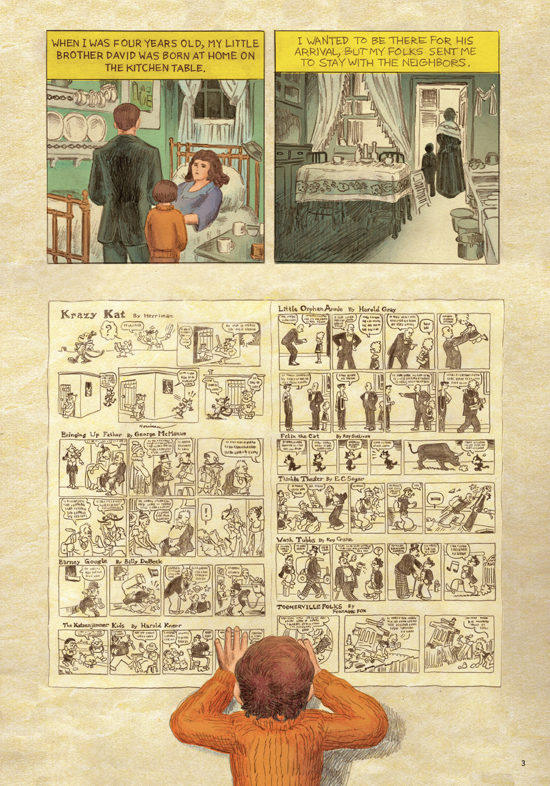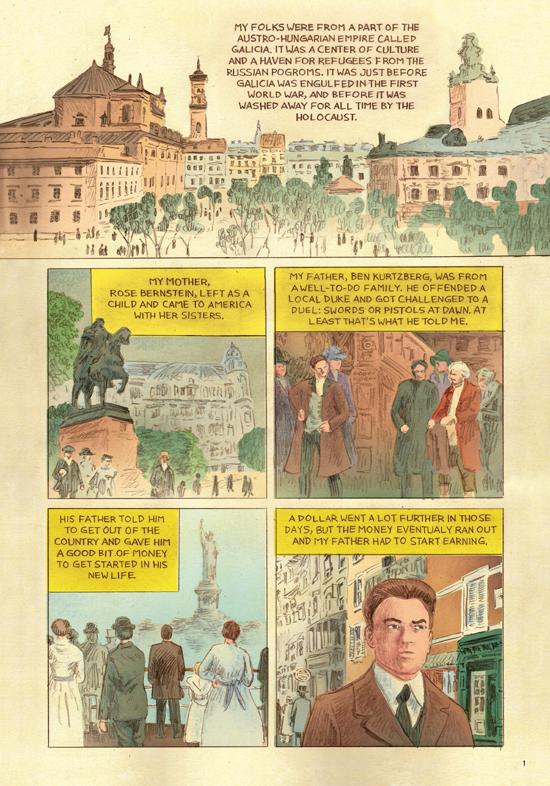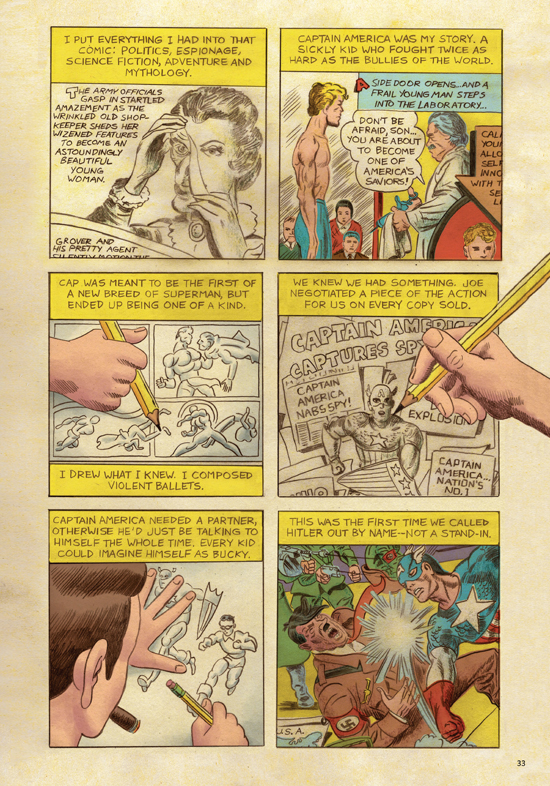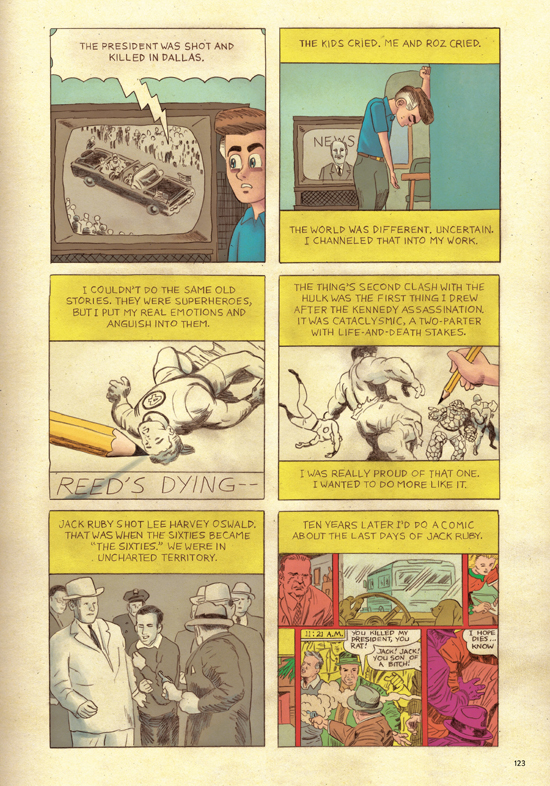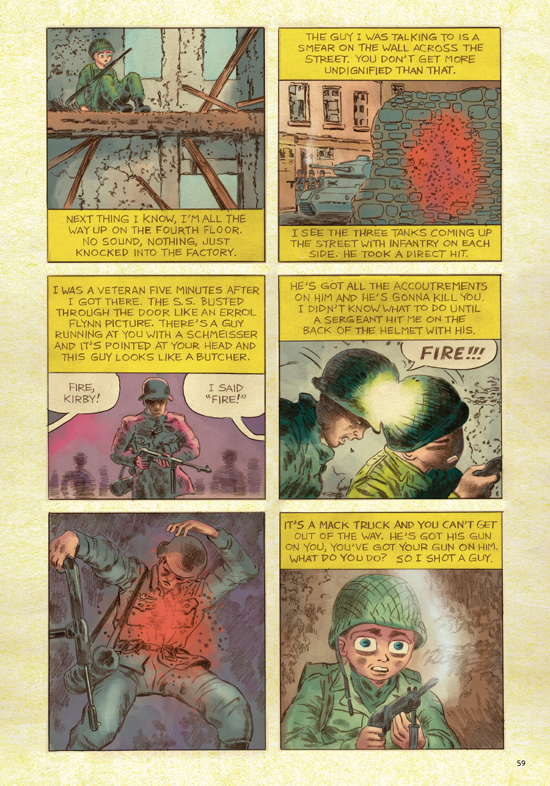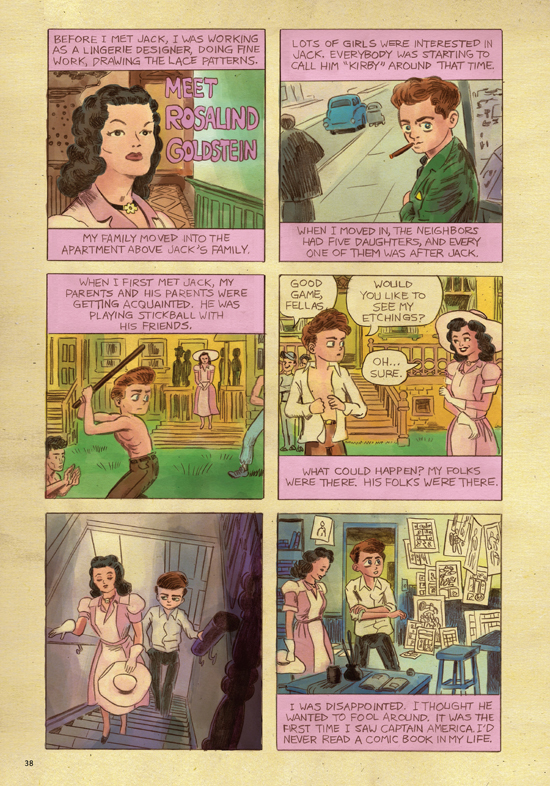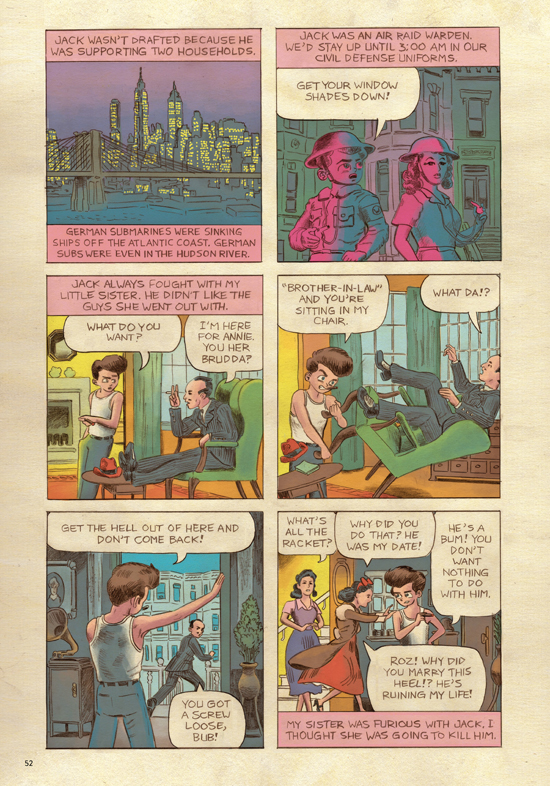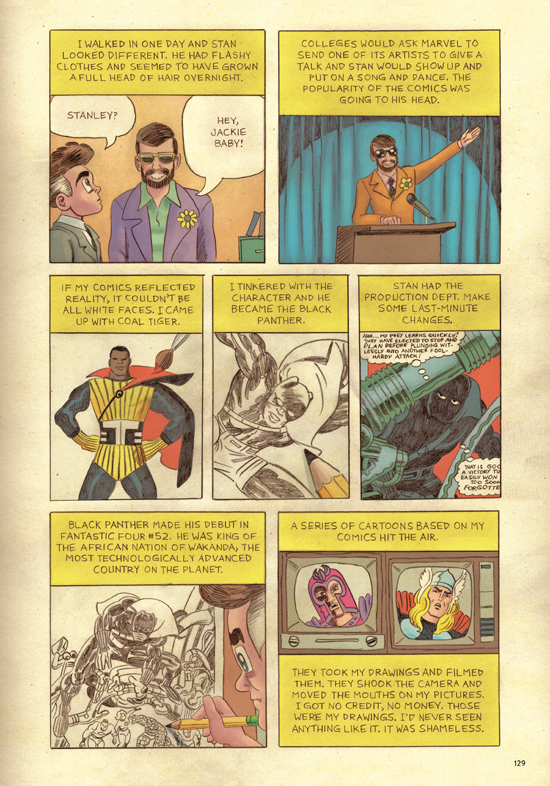OFF-TOPIC (19)
By:
July 10, 2020
Off-Topic brings you over-the-transom, on-tangent essays, dialogues and subjective scholarship on an occasional, impulsive basis. This time, a check-in with one writer-artist forging comics’ next steps, on his retrospective of a predecessor the artform is still catching up to…
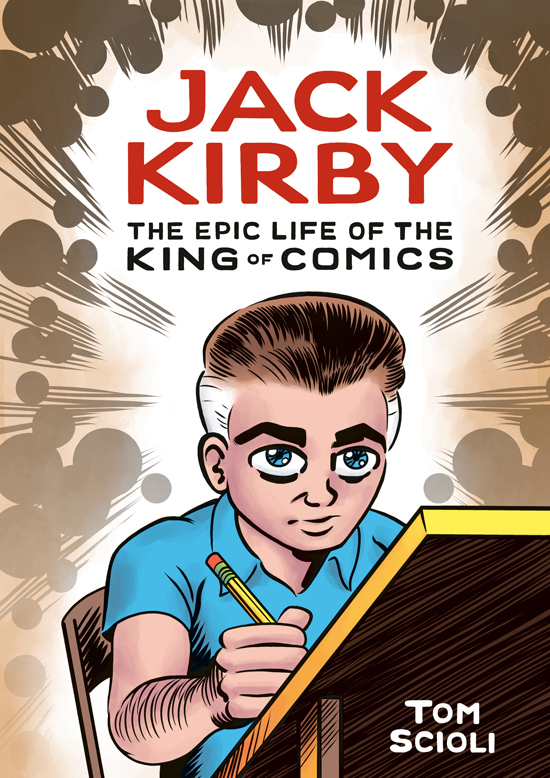
We trace the shapes of ancient heroes and heroines, mythic beasts and even mystic artifacts in the stars; taken together, the entire night sky might connect into Jack Kirby. A prophet of 21st century cosmic spectacle in entertainment and possible transcendent higher-dimensional existence yet unseen, Kirby was like the subterranean furnace-god fashioning all the shiny, sky-spanning wonders we enjoy in popular entertainment (and increasingly, architecture, design and transport) today. Creating the riches while others claimed the glory, Kirby’s name stayed in the shadow of his own inventions, and collaborators, until an era of more democratized media and evenly-distributed egos. That’s still a work in progress, but Tom Scioli’s graphic biography Jack Kirby: The Epic Life of the King of Comics, adds many indelible brushstrokes to the portrait that has been emerging.
It’s the first full life story of the artist in the medium where he made his mark (other slices of that life have appeared in Fred Van Lente & Ryan Dunlavey’s Comic Book History of Comics and James Romberger’s For Real, in addition to the biographical play King Kirby by Crystal Skillman and Van Lente). It sweeps from his early-20th-century tenement upbringing to his WWII service, and his titanic career creating or collaborating on some of the most recognizable characters in pop culture (Black Panther, Captain America, too many more to mention). It takes in the recurring nightmares his combat experience left him with, and the battles he endured for dignity, credit and compensation as the quintessential working stiff in factories of imagination that sometimes blurred together with the sweatshops of his parents’ generation — but which, in Kirby’s hand, came to collapse the boundaries between elite and popular forms of cultural expression.
Scioli has been leading up, and back, to this story for his 20-year career; renowned for his extension of the Kirby style of fevered supernatural sci-fi and visionary pyrotechnics, as well as his own intricate, elegant design sense, pithy linguistic play and inspired askew humor, Scioli has reached a point from which he has a clear view to Kirby’s origins and influences. Told in the panel-grid form of Kirby’s mature style (where all the extravaganza you could handle happened inside the box), and employing the panorama of aesthetics he has grown into to collage and convey a span of history and worlds of difference, Scioli creates the feeling of an odyssey through long-lost relatives’ family albums or stacks of letters and postcards; we feel as if the book was written by Kirby himself, directly for us to find (with guest-narration from his indestructible wife Roz and even his most iconic partner and best frenemy Stan Lee). Jack Kirby created sights no one else could ever have imagined, and they’re now on any giant movie-screen to see; Scioli’s bio puts us into his large life and epic times as his own eyes might have witnessed it.
I spoke with Scioli via the kind of media his subject would have dreamed of, during the kind of apocalypse he used to worry about, to discuss true futures, creative pasts, accurate contradictions, transmuting life to story and back again, and what only comics can tell you…
HILOBROW: How are you doing in sequester?
SCIOLI: I was basically sequestered while I was working on the Kirby book, then I finish it and I’m ready to enjoy life, and you’re back in seclusion.
HILOBROW: I’m glad we’re keeping you safe for posterity [laughter]. You clearly did so much work in researching and absorbing [his] background… Kirby was famous for having recurrent but variant versions of his war stories, not to mention his and Stan’s freighted memories of what happened in the Marvel years; were there any points where you had multiple versions of the same account, and you had to either synthesize them or make a decision as to which version sounded most credible?
SCIOLI: Yeah, exactly. I don’t know if you’ve ever heard that Malcolm Gladwell podcast where he talks about false memory — we’ve learned a lot in recent years about false memory, and how it operates, and how it’s done without any kind of malicious intent; you tell stories, and every time you tell a story, a detail might change, and then you can’t discern the difference between the actual things that happened and the little [divergent] details that accumulate, and if you tell a story enough times, or think about an event in your life enough times, it does start to get this baggage that can take it in weird places. So I understood that, reading these Kirby [anecdotes]; also, it makes you less judgmental towards the people, Kirby or Stan Lee or whoever, in that they’re telling two conflicting stories, but they could very well both believe that they’re telling the truth. But yeah, with Kirby, there were details here and there where it’s like, okay, he’s told this story this way, and he’s told it [that] way, so, which one am I going with?
HILOBROW: So it’s all the cooler that we have the counterpoint of your notes at the back, so we see your hand in the ways you’ve phrased it, and the sources, which are sometimes one-to-one and sometimes different. And you do a great job at what he “could have” said.
SCIOLI: I was definitely getting into character.
HILOBROW: The elaborations of memory aren’t so far from the building of story… the one time I ever interviewed Spalding Gray he said, “I don’t think we realize how creative we’re being with our memories.” Kirby was famous for carrying his fictional sagas around in his head, and brainstorming aloud in great detail to an associate, and then completely improvising when it got to the drawing board.
SCIOLI: Yes, he was a great improv-er. There just wasn’t time to plan ahead for the volume of work he was producing.
HILOBROW: When you were doing his story, did you ever find yourself course-correcting, or going back over how to tell the story and what to accentuate, or did you just absorb as much as you could and then barrel ahead like he would have?
SCIOLI: I took it chronologically, but I did go back here and there and add this little bit in, or streamline that, and every so often reassess the structure of the whole thing. I reached a certain point in the story and did a new outline of what the rest of the book [was] gonna be. As you’re making this thing, you come in with a certain amount of information, but also I’m learning at the same time, and the information I have is coming into greater and greater focus; there’s a clarity that you get just in the act of working on this, that you have to be open to constant revision. Because when you’re setting out at the beginning, even on something like this where it’s nonfiction, you don’t know exactly what shape this thing’s gonna take. You get a better idea as you’re knee-deep in it.
HILOBROW: The many excerpts from his comics are to this book as film clips are to a documentary; was it important to you to re-create all of those by hand?
SCIOLI: It’s part of the fun! It’s a lot of fun drawing Jack Kirby at the drawing board drawing what he’s drawing. As one of a small number of people who have practice doing that, it’s not hard for me to get into character and do that Kirby thing.
HILOBROW: True, though this book shows the widest range of stylistic vocabulary that you’ve ever had; a remarkable spectrum.
SCIOLI: When I got the printed book back, I was thinking, this is almost like my autobiography [laughs], it’s almost a catalogue of everything I care about, everything I’m into, even if it’s like, talking about how the Christopher Reeves Superman relates to Jack Kirby; and then getting into the ’80s, his animation era, seeing him work on the Mr. T cartoon, this stuff is very personal for me too.
HILOBROW: It does get fascinating when these things start intersecting with your own lifetime. At various points, the re-created original art seems to… at least in the earlier pages, often the excerpted panels we see seem to be a meta-commentary, a subtext to what’s going on in his life — did you sift for that kind of thing, or was it more intuitive?
SCIOLI: Largely intuitive… the Captain America stuff, I was really, I had only recently acquired the complete Golden Age Simon & Kirby run, and I was just wrapping my head around it… and for a moment the book almost becomes like literary criticism, where I’m unpacking all this Captain America stuff, because it was hitting me in the face, it was a part of his career that I hadn’t thoroughly given that kind of attention before. Because there’s a lot of Kirby’s work where, the wow-factor I’ve already absorbed; I was knocked off my feet by, say, New Gods #7 back in 1994; you’re watching me get knocked off my feet by 1940s Captain America [laughter]. When that came out, it was just such a relevant comic, “torn from today’s headlines,” it was so immediate — television wasn’t a thing yet, most movies were black-and-white, so you have this full-color thing that’s accessible, and right there, and right on the cutting edge.
HILOBROW: It’s funny, even though as a kid I wore out my copy of Jules Feiffer’s The Great Comic Book Heroes, not least the Captain America origin story, I’d completely forgotten how FDR is in there, asking ruefully if the war could be won by “a character out of the comic books” and thus basically situating Captain America outside of the Marvel Universe, which is fascinating.
SCIOLI: That’s kind of a part of Kirby’s career throughout; “what everybody else is doing is make-believe, is fantasy; what I’m doin’ right here is the real deal, I’m doin’ real life. If you look out your window you might see one of my characters swinging by.” And it’s right there in Captain America #1.
HILOBROW: Even earlier in that section, I love the panel where little Jake Kurtzberg is running away from the landlord and going through his legs and in the background you see this Galahad-esque hero and bemused old guy that he’s scribbled on the walls — I loved counterpoints like that, which I’m sure were more yours to orchestrate since I don’t think any of his vandalism survives [laughs].
SCIOLI: Y’know, you talk about comics like Watchmen, where it’s like, “this could only exist in comics form,” or where comics are the perfect medium for telling this story. And like, yeah, just taking advantage of what comics can do, so you have the lines on paper of the actual person doing things, and you have the lines on the wall in the background or the lines on the paper that he’s drawing, and you get to have these embedded, like a nesting doll of stories being told. And it was interesting how much information you could pack into a panel and have it still seem naturalistic. It doesn’t interrupt the reading flow. Because everything you look at on that page, whether it’s real or imagined, or a drawing or signage, or a bubblegum card or whatever, it’s all just lines and words on paper, and color, so there’s a unity to all these different elements.
HILOBROW: As the book goes on, first we have more documentary, or narrated excerpts from Captain America or The Vision, etc., and then later on there’s so many panels of Kirby facing his drawing board, almost as if it’s a mirror, and the realest reality of his life is on the page and looking back at him. The later you go in his life, the more he was literally sitting at a drawing board for most of his waking hours, but the way you handle that is amazing for both incorporating why we should be impressed by this guy, and also enlivening the static nature of his earthly life.
SCIOLI: In the planning of this — and again, talking about why comics is the perfect medium for telling [this] story — there’s a lot of drama, action and excitement that’s very external in the early part of his life. Because you do have the gang fights, you have him hittin’ the streets and going from publisher to publisher in Manhattan, you have his war experience, you have [him as] father of young kids; there’s all this external-world excitement and drama. And then he hits a point where — the part of his life we’re probably most interested in, because it’s when he’s making all these things we love, the ’60s Marvel stuff, the ’70s Fourth World, all that stuff we’re most interested in as fans — there’s no action. It is just a guy at a drawing board. A movie of a guy at a drawing board, that’s a real challenge. But then it’s like, well, he’s at the drawing board, and he’s drawing these compelling universes and envisioning all this stuff, and having a lot of internal drama of these fights and simmering resentments about credit and compensation and “will I be forgotten.” Comics is great for showing an internal reality. And the internal reality can be visceral.
HILOBROW: To the point of the way that his external and internal realities, and his memories and his imaginings entwined, one particularly memorable page for me was where he’s talking about bringing back Captain America in the ’60s, and the way that his voiceover weaves that together with his experience, talking about how “Ice got me out of the war and saved my life” [Kirby was sent home after almost losing his feet from frostbite; Cap was frozen in the Arctic for 20 years] — was that a quote from anywhere, or were you just drawing on his way of making connections?
SCIOLI: To be honest, at this point I don’t remember! [Laughter] I would have to go check my notes. Because there are things in there where — and again, I got so into character, that just off the top of my head, I forget certain parts of, okay, is that an actual quote from Kirby, is that something I created? But I don’t think I’m clever enough to have come up with that, I think I probably did find somewhere him making a reference to ice…
HILOBROW: In any case he must have said it in retrospect, so it raises fascinating questions about how much was on his mind at the time, how much he realized about his own reasons…
SCIOLI: I think he was a largely intuitive creator, he worked from his gut, and that’s why so much of his stuff is so profound, because he’s not overthinking it; he opened this door to some deep part of his subconscious and stuff just comes out. I don’t think he had very many opportunities in life to go back over his work and think, “this is what I was thinking.” So I would imagine… there had to be an awareness… he’s telling the story of Cap, and what’s Cap been up to since the ’40s. And it is this story of loss, and he would talk about how, “I went to war with such-and-such number of guys, and then me and two other guys came back,” that kind of stuff. He would always say, “the people in my stories, they’re real people, I know them, I’m telling real stories,” it’s sort of like the lie that tells the truth; he would tell these fantastical stories that had all the elements of autobiography.
HILOBROW: Speaking of how he would convert some of his experiences to stories, there were a few passages that aren’t even remarked upon in the narrative that hit me — like, only this year did I ever get to read the full True-Life Divorce, and in his recollections in your book about his tense relationship with his sister-in-law and her boyfriends I thought, “oh, that’s directly where ‘The Twin’ comes from!”
SCIOLI: I was thinking of that too; I’d just read all of True-Life Divorce very recently. As I was reading it I was kinda like, “oh, yeah…” ’cuz Kirby had this role, he was like the breadwinner, the “man of the house” for a larger household; he was the guy who was paying all the bills for his in-laws, and his family, for a period of time — prewar and as the war’s coming together, not very many people around him are making much money, and all of a sudden he has this very lucrative job, and he’s almost like the dad to his sister-in-law, and he would tell these stories of standing guard at the door, and some guy comes over and he’s checking him out, and he’d kick guys out, and throw chairs around… it’s a very different Kirby than we understand, just knowing the gentle old man that we’ll see in interview videos and things.
HILOBROW: Amidst all the stylistic diversity and variety of visual vocabularies in your book, one thing that’s consistent throughout is the look of Kirby himself, with this almost manga treatment, almost a “Roger Rabbit” thing, where he’s the only one who looks like that and everybody else is drawn “realistically.” Was that meant to set him off, or make him this figure who’s kind of a part of history, as opposed to someone with a finite lifetime, or… was it that he’s so known to us through his work that he had to be cartooned in some way?
SCIOLI: There’s layers to it and there’s different things that it accomplishes, but the main thing I was setting out to do with it was just looking for greater reader identification. It just makes you a part of his story more. Like that Scott McCloud idea of “masking,” where the more cartoony your main character is, the more the reader will identify with and see themselves in that character. And that you make the external world more photorealistic, to create this sensory, sensual world that you can explore as that character. There also was something of an arrested development that could be the result of PTSD — literal PTSD in his wartime experiences, but also, his childhood was very violent — and kind of keeping him in this eternal childhood. Though even the cartoon version of Kirby still ages over the course of the book.
HILOBROW: In one way it almost makes me think of what he says about how the Sandman needed an upgrade from his pulp-hero image to look more contemporary to the ’40s. If this had been 10 years from now, might there have been a different reference point than manga, would you have chosen the more ubiquitous cartoon look of the 2030s?
SCIOLI: Manga, that’s a very specific reference point. And of course I learned these lessons from manga. But I feel they hit on something universal with that. There’s that show Manben where they interview different mangaka and go in their studio. And one of the artists was saying, “I didn’t have much success until I started drawing characters with large eyes and big expressions.” I think it’s a very elemental psychological thing that goes beyond the specifics of manga, like you draw a face that has the proportions of a baby, and a certain degree of simplicity. And it’s like the happy feeling you get when you look at a baby. This discovery was made in manga, by cartoonists, in a certain era, in a certain geography in Japan, but it’s universal. It’s a lesson that can be applied anywhere. And I’m sure I’m not the first person to be making this observation either. So it wasn’t like, it wasn’t so specific to manga… that visual language is pretty ubiquitous; it’s in videogames, it’s in emojis.
But also, to your question, if I were to do this comic again, I could make an entirely different Life of Jack Kirby graphic novel and it would be a very different experience, totally different from this. There’s just so much there, and so many ways you could do it, that, yes, I could do this again in 10 years and have a completely different book.
HILOBROW: That’s the richness of his oeuvre, how many angles it can be looked at from and yield something different — part of what’s kept a magazine like The Jack Kirby Collector running for over 20 years!
SCIOLI: It never ends. When you think you’ve seen or heard everything there is to see or hear about Kirby, they dig up some new thing. Even like that [prose] novel he was working on, The Horde, I’ve not seen any manuscript of that. I’ve seen some excerpts, and some curated [sections] of it that have seen print. But that’s a pretty large part of Kirby’s body of work that just hadn’t seen the light of day, just his raw Horde manuscript, I’d love to get my hands on that. And I know that [Kirby Collector publisher/editor] John Morrow was allowed to read it — I don’t know if they left him in a room with it like Citizen Kane [laughter] — but he was allowed to read the entirety of it, and then it’s sort of quickly taken away from him [laughs]. But, what is it, 103 years later and we’re still just scratching the surface of the Kirby ocean.
HILOBROW: The way it’s described, and from what little we’ve seen, everyone is like, “oh, there’s no throughline, he just keeps introducing different characters,” etc. — which of course is the same thing people said about The New Gods — but these days we’re so much more used to a disjointed, de-linearized form of storytelling I bet it wouldn’t need as much patch-up as people have thought it would.
SCIOLI: I agree.
HILOBROW: That’s the next holy grail, now that we’ve seen True-Life Divorce.
SCIOLI: That’s on the list!
HILOBROW: We were talking about expressions and faces; it seems that there’s a recurring motif of hands in this book too. People who watched him draw always said that Kirby would do the hands first… between the fact that we know that about him, and other strange scenes that focus on hands, like where he’s talking to the piano player [a rival for eventual wife Roz’s affection] to scare him away with “what might happen to those hands,” that has a lot to do with the physicality of how media used to be created, and of course you still do many things manually that most people don’t anymore. That also comes out in the way that Kirby was known for all this fantastic tech, and in this book you really lovingly re-create real-life, basic machinery like printing presses, etc. Was that an important theme to sound, even if it was undercurrent?
SCIOLI: He’s a guy who lived through his hands. Talk about muscle memory, so much of the drawing process sometimes feels like your hand has a mind in it, your hand is guiding this, you’re just kind of following where your hand’s going. And then in old age when your hand starts to fail you, you get a tremor, or can’t quite hold the pencil, you’re sort of betrayed by your hand.
HILOBROW: There’s a few other recurring motifs, and this goes back to what we were discussing about the structuring of this book; I’m curious if these just naturally popped up. In particular, there’s one about artistic treasures being salvaged from trash, like when Larry Lieber is retrieving some ripped-up Kirby pages to study from, and of course the famous shrine Marie Severin made from Kirby’s cigar-butt when he quit Marvel. And there’s a few instances where we see Kirby coming toward us in the darkness with a doorway behind him holding a shadow of someone watching him go (parting ways with various collaborators or partners). Did these just come up organically, or did you come to certain points where you thought, “okay, here he is again so we can use this image”?
SCIOLI: That’s a Kirby [compositional] motif for sure, a person framed in a doorway with someone walking off into the sunset, moving on. As to things being discarded and found, that’s Jack Kirby’s origin story, that sci-fi magazine he found, in a gutter, that was about to go down the drain of a sewer grate; he finds it and discovers science fiction.
HILOBROW: That’s an amazing connection. It’s clear the deep research and expert emulation you did of the comic and other pop-culture sources; what kind of references did you work with photographically for the surrounding world?
SCIOLI: We’re talking about background. We’re not talking about what’s going on in the foreground, characters, etc., we’re talking about the environments. That’s almost invisible work, you don’t put a ton of thought into that as a reader. But creating this book, that was probably the biggest challenge; that was the most man-hours, and thinking, and decision-making, because I have to tell a story that spans decades. And spans almost the entirety of the 20th century. You just think about all those changes; every decade looks different from every other, every half-decade looks different. So I’m having to track fashion trends, how colors come in and out of fashion, how architecture comes in and out of fashion. And then [how] some things persist beyond their era, so like, a house from the ’40s that you’re still living in in the ’50s; what does a store look like, what does a restaurant look like in the 1950s vs. the 1970s. And I was just pulling from everything — like Jack Kirby would pull from LIFE magazine and magazines of that era, I was looking at those, and of course the internet; if you’re really hard-up for, okay, “what did a barstool look like in 1948,” you have the internet there too. It was a task. Sometimes I wondered if I was overthinking it. But… the job is done [laughs]. If I put too many hours into figuring out what a living room looks like, at least it’s behind me.
HILOBROW: For me it was worth every minute! It has such a degree of verisimilitude… like, even Roy Thomas’ egregious ’70s shirts [laughs].
SCIOLI: The Roy Thomas stuff was great, because there’s video footage. I was watching this video of him interviewing Stan Lee, and he’s just wearing this complete denim suit — everything on his body is denim. Great! With some of the fashions, I kind of had to tone it down a little bit, because if you presented the reality of some of these outfits, it’s too distracting; all you’d be thinking about is, “what is up with that belt?” I had a lot of fun with the fashion, the ’70s stuff is fun. And, like, in the mid-’60s there’s just this radical cultural change that happens, and Kirby’s generation, it takes a couple years for them to catch up with it; Stan famously is somewhat of an early adopter and gets onboard with the fashion, maybe to a point where you could almost ridicule it. But then by the ’70s everybody’s wearing loud, crazy patterns — I remember John Lennon was on the Tom Snyder show at some point in the ’70s, and Tom Snyder is talking to him, like, “Oh man, the era when you guys came on the scene — and those crazy haircuts!” and John Lennon is like, “Well, your haircut right now, is the Beatles haircut” [laughter], “that thing that was so crazy to you has become the norm. And you’re as straight and square a person as there is, and that’s what you’re wearing.”
HILOBROW: Talk about the invisible background! But yeah, I’m very hung up on period-specificity, just ’cuz I feel that… it’s like a puzzle piece into which the people from that era fit, and if you get that wrong, it loses the believability. I love the connection you make to how Kirby would always do his research in magazines, which I guess was his internet; like he was “researching” the present. Which I guess is fitting for a guy who was so easily distracted, and living in the future. Speaking of, had you been scheduled for any signings etc. that are now on hold?
SCIOLI: This year I was supposed to be on a whirlwind tour; Free Comic Book Day there was supposed to be an excerpt of this coming out, I was gonna go to San Diego… that’s just not part of the business model this year.
HILOBROW: Hopefully we’ll help give it as high a profile as possible!
SCIOLI: I want the world to know about Jack Kirby. When somebody’s watching one of these movies, I want them to think of Jack Kirby just as readily as they think of Stan Lee.
All images from JACK KIRBY: THE EPIC LIFE OF THE KING OF COMICS. Copyright © 2020 by Tom Scioli. Published by Ten Speed Press, an imprint of Random House, a division of Penguin Random House LLC.
MORE POSTS by ADAM McGOVERN: OFF-TOPIC (2019–2025 monthly) | textshow (2018 quarterly) | PANEL ZERO (comics-related Q&As, 2018 monthly) | THIS: (2016–2017 weekly) | PEOPLE YOU MEET IN HELL, a 5-part series about characters in McGovern’s and Paolo Leandri’s comic Nightworld | Two IDORU JONES comics by McGovern and Paolo Leandri | BOWIEOLOGY: Celebrating 50 years of Bowie | ODD ABSURDUM: How Felix invented the 21st century self | KOJAK YOUR ENTHUSIASM: FAWLTY TOWERS | KICK YOUR ENTHUSIASM: JACKIE McGEE | NERD YOUR ENTHUSIASM: JOAN SEMMEL | SWERVE YOUR ENTHUSIASM: INTRO and THE LEON SUITES | FIVE-O YOUR ENTHUSIASM: JULIA | FERB YOUR ENTHUSIASM: KIMBA THE WHITE LION | CARBONA YOUR ENTHUSIASM: WASHINGTON BULLETS | KLAATU YOU: SILENT RUNNING | CONVOY YOUR ENTHUSIASM: QUINTET | TUBE YOUR ENTHUSIASM: HIGHWAY PATROL | #SQUADGOALS: KAMANDI’S FAMILY | QUIRK YOUR ENTHUSIASM: LUCKY NUMBER | CROM YOUR ENTHUSIASM: JIREL OF JOIRY | KERN YOUR ENTHUSIASM: Data 70 | HERC YOUR ENTHUSIASM: “Freedom” | KIRK YOUR ENTHUSIASM: Captain Camelot | KIRB YOUR ENTHUSIASM: Full Fathom Five | A 5-part series on Jack Kirby’s Fourth World mythos | Reviews of Annie Nocenti’s comics Katana, Catwoman, Klarion, and Green Arrow | The curated series FANCHILD | To see all of Adam’s posts, including HiLo Hero items on Lilli Carré, Judy Garland, Wally Wood, and others: CLICK HERE

